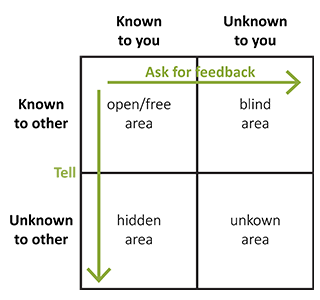Dec 14, 2023
This is about you taking ownership of your growth and learning. Each individual is unique with their own interests, skills and preferred ways of doing things. For this reason, when it comes to professional development and personal growth, who better to decide on personal practices and tools than you.

Praxis is the practice of doing something, reflecting on it, and doing it again differently because of what you learned. A contemplative practitioner knows the value of praxis and is committed to regular practices, tools and times for doing this.
Praxis in a person’s day-to-day work is healthy and helpful for personal, team and organizational growth and wellness. As illustrated in the Johari window, as a contemplative practitioner, we are working to expand what you know about yourself.
Here are contemplative practices to consider:
- Journaling. Carve out a regular time in your day to reflect. Whether this is first thing in the morning, over lunch or after your workday is done, an intentional and consistent time to think back and wonder can be helpful. Additionally, having a journal close by as you work will allow you to jot down thoughts, ideas, quotes, and questions as they come to mind. Then, you can revisit these at the end of the day, week or month and allow them to inform future action and decision-making.
- Drawing and doodling. For some, it is helpful to reflect visually. Whether that means taking a sketchbook with you to work or that you start and end your day in this way, drawing or doodling out your ideas, feelings and wonderings can uncover surprising elements for personal growth.
- Inviting others in. We all get stuck and lose motivation at times. This is a natural part of working. But remember, you have team members for a reason! The next time you find yourself stuck or struggling with something, ask a colleague for help. Their energy and perspective can help you get back on track.
- Lunch and learn. Propose to a colleague that you eat lunch together (virtually or in-person). Ask that person for feedback on something that you did at work, internally or externally. It could be a meeting you facilitated, a partner presentation, or other facilitation processes. Ask the question, sit back and listen to what they have to say; it is not a time for debate or to defend yourself. It is a time to hear how others see and experience you – a time to learn.
- Move and talk. Similar to a “Lunch and Learn”, this is an invitation for a colleague to reflect back what they see in you as you move about your space – this can be indoors or outdoors, in-person or by phone. Use the Johari window (above) to help determine how and what to ask for feedback on.
- Silent retreat. Introverts love this but it can be helpful for extroverts as well. Find a time at the end of a day, week, month, or year to be by yourself. Set an intention to reflect on things that you do well and areas that you want to improve. This is a great opportunity for uninterrupted mediation, yoga, or martial arts practice. You can bring your journal along to capture your thinking or allow the thoughts to wash over and pass through your mind.
What tool have you tried or are you interested in trying to support your commitment to being a contemplative practitioner?
Jeanette Romkema is a Senior Partner and our Certified Network Director. Tyler Phillips is a GLP Partner.
Here are more GLP blogs by Jeanette and Tyler.
This blog was originally published on January 14, 2021.



